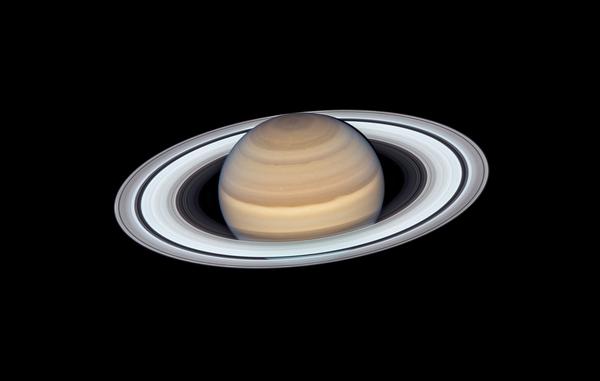This page describes an image Saturn
Image caption:
The NASA/ESA Hubble Space Telescope’s Wide Field Camera 3 observed Saturn on 20 June 2019 as the planet made its closest approach to Earth this year, at approximately 1.36 billion kilometres away. The image shows coloured bands of gas on the planet's surface as well as its prominent rings made of ice and rocky material.
Scroll to captions in other languages
Image credit:
NASA, ESA, A. Simon (Goddard Space Flight Center), and M.H. Wong (University of California, Berkeley) Credit Link
Related glossary terms:
Gas Giant
, Giant Planet
, Outer Planets
, Ring
, Saturn
Categories:
Solar System
Image license: Creative Commons Attribution 4.0 International (CC BY 4.0) Creative Commons Attribution 4.0 International (CC BY 4.0) icons
The media file captions presented on the OAE website were written, translated and reviewed by a collective effort from the OAE, the OAE Centers and Nodes, the OAE National Astronomy Education Coordinators (NAECs) and other volunteers. You can find a full list of credits for our translation project here. All media file captions are released under a Creative Commons CC BY-4.0 license and should be credited to "IAU OAE". The media files themselves may have different licenses (see above) and should be credited as listed above under "credit".
If you notice a factual error in this caption or an error in any of its translations then please get in touch.
Captions in Different Languages:
Image caption: La caméra à grand champ 3 du télescope spatial Hubble de la NASA/ESA a observé Saturne le 20 juin 2019, alors que la planète s'approchait au plus près de la Terre, à une distance d'environ 1,36 milliard de kilomètres. L'image montre des bandes colorées de gaz à la surface de la planète ainsi que ses anneaux proéminents composés de glace et de matériaux rocheux.
Image credit: NASA, ESA, A. Simon (Goddard Space Flight Center), et M.H. Wong (Université de Californie, Berkeley)
Related glossary terms: Anneau , Giant Planet , Géantes gazeuses , Planètes extérieures , Saturne Caption translation status: Approved by a reviewer
Caption translators: Gilles Remy
Caption reviewers: Lionel Ruiz
Image caption: La Wide Field Camera 3 del telescopio spaziale Hubble della NASA/ESA ha osservato Saturno il 20 giugno 2019, il giorno in cui il pianeta si è avvicinato di più alla Terra in quell'anno, a circa 1,36 miliardi di chilometri di distanza. L'immagine mostra le bande colorate di gas sulla superficie del pianeta e i suoi anelli più evidenti, composti da ghiaccio e materiale roccioso.
Image credit: NASA, ESA, A. Simon (Goddard Space Flight Center), e M.H. Wong (Università della California, Berkeley)
Related glossary terms: Anello , Gigante gassoso , Pianeta gigante , Pianeti esterni , Saturno Caption translation status: Approved by a reviewer
Caption translators: Giuliana Giobbi
Caption reviewers: Rosa Valiante, Rodolfo Canestrari
Image caption: NASA/ESA 哈勃太空望远镜的宽视场相机3号于 2019 年 6 月 20 日观测到土星,当时这颗行星距离地球约 13.6 亿公里,是今年距离地球最近的行星。图像显示了土星表面的彩色气体条带以及由冰和岩石物质组成的突出星环。
Image credit: 美国国家航空航天局、欧空局、A. Simon(戈达德太空飞行中心)和 M.H. Wong(加州大学伯克利分校)
Related glossary terms: 土星 , 外行星 , 巨行星 , 气态巨行星 , 行星环 Caption translation status: Not yet approved by a reviewer
Caption translators: Hu Xueying
Image caption: NASA/ESA 哈勃太空望遠鏡的寬視場相機3號於 2019 年 6 月 20 日觀測到土星,當時這顆行星距離地球約 13.6 億公里,是今年距離地球最近的行星。圖像顯示了土星表面的彩色氣體條帶以及由冰和岩石物質組成的突出星環。
Image credit: 美國國家航空航天局、歐空局、A. Simon(戈達德太空飛行中心)和 M.H. Wong(加州大學伯克利分校)
Related glossary terms: 土星 , 外行星 , 巨行星 , 氣態巨行星 , 行星環 Caption translation status: Not yet approved by a reviewer
Caption translators: An automated transliteration from the simplified Chinese translation by - Hu Xueying









